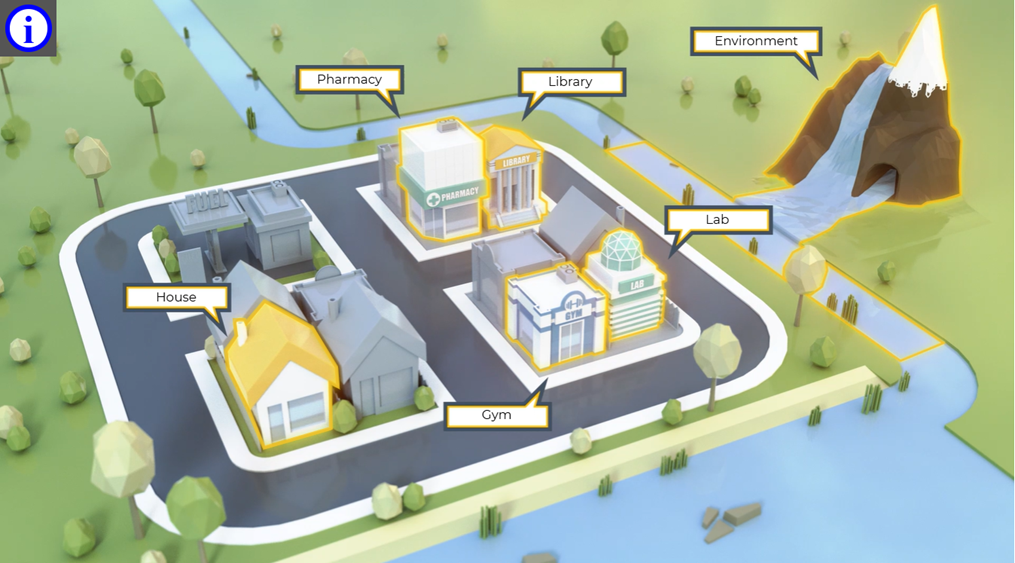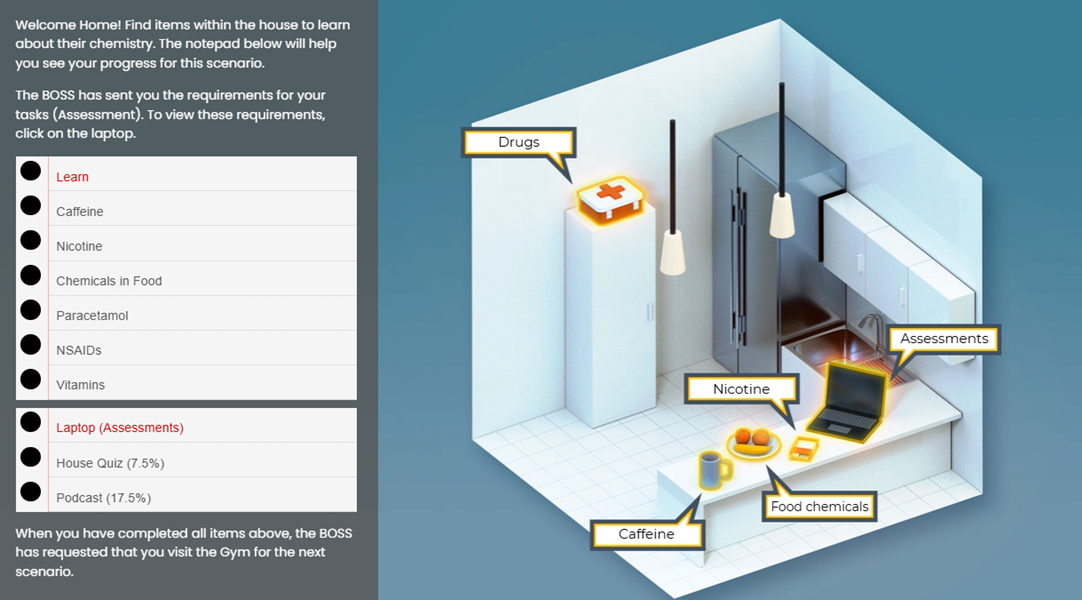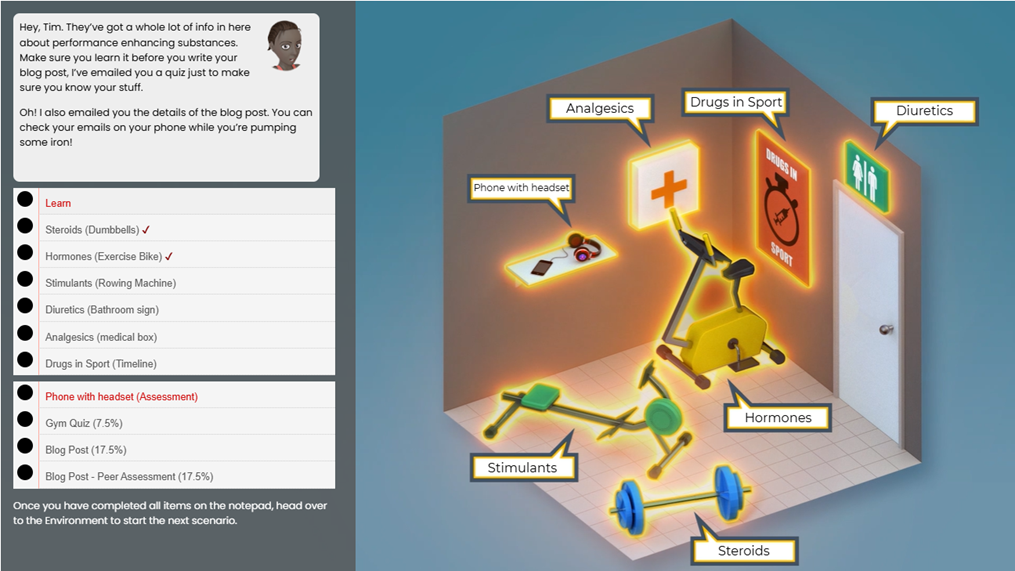Engaging Students with Chemistry Through ChemTown

Stephen Ralph | Science, Medicine and Health
Stephen and the CHEM200 teaching team co-designed with students and LTC colleagues an interactive game environment using scenario-based learning.
CHEM200, Living in a Molecular World is a subject designed to be available for students from across the University. The subject design focuses on an interactive, scenario-based learning activity called ChemTown. The creation of ChemTown involved a range of stakeholders, including members of the CHEM200 development team, students and Learning, Teaching and Curriculum (LTC) staff.
ChemTown connects theoretical concepts and real-world applications, aligned with the Subject Learning Outcomes (SLOs), to create an interactive experience that incorporates a narrative-style format. The design aims to communicate scientific ideas in ways that are both engaging and easy to understand for audiences with varying levels of knowledge and background in the topic.
In the video below, we hear from Stephen Ralph, a member of the teaching team, on the importance of ChemTown in the delivery of CHEM200.
Stephen Ralph: Hi, my name is Stephen Ralph. I'm from the School of Chemistry and Molecular Bioscience, and I've been the course coordinator for CHEM200 for the past five years. I think CHEM200 is a very important subject because it's the only one of its type that enables students from all degrees across the university to be able to engage with a lot or a wide range of scientific concepts. So we needed to find a way to be able to deliver, I guess, this sort of understanding of chemistry and what's going on in our everyday lives, what we see around us.
How does it actually work? So the centrepiece of CHEM200 is a interactive Moodle lesson called ChemTown, and within ChemTown there are these different locations, all corresponding to different aspects of chemistry or science.
For example, one is the environment, another is the pharmacy section, and also we have a section which is the one the students first encounter, which is called the house. And the idea behind that is we want students to go in and see everyday substances, products, etcetera in the house and actually start to think about the chemicals inside them, are they safe, what do they do, how do they do it, etcetera.
So one of the most important outcomes for ChemTown is the development of digital literacies for our students, and the way that we very overtly do this is that we've made some of the major assessment tasks for the subject, ones that require students to develop these multimedia skills.
It's increasingly important for the students to have really good presentation skills prior to leaving the university and going out into the workforce, and this is probably one of the first subjects with a chemistry badge, certainly, where students get to demonstrate or build a range of communication skills, for example, giving podcasts and developing video presentations.
Why?
Using scenario-based learning pedagogy (Errington, 2015), ChemTown enables students to explore complex scientific concepts through relatable, real-world applications.
In the image of ChemTown below, each of the locations on the town map aligns to a different scenario; the House, Pharmacy, Library, Gym, Lab, and the Environment. 
In the video below, Stephen speaks to how students progress through ChemTown.
Stephen Ralph: One of the aspects that we incorporated into the ChemTown Moodle lesson was whenever a student enters a new area, they encounter a different character and this character provides context for the content of that particular area, and they also introduce them to what the assessment tasks will be.
Within each of the different areas of ChemTown, there are always 2 tasks and students were being directed to complete these tasks by the characters that they encountered, and a number of occasions what the students will have to do is they will have to submit their assessment task either via an iPod or a computer or something that they see within the actual Moodle environment.
So the students, they will feel like they're not actually leaving the environment or that they're actually in the environment of ChemTown when they submit their task. One of the aspects I like about ChemTown is that it's an area where students can go and explore, much like a video game.
We wanted to introduce elements of completion, having to complete sections of ChemTown before they are able to move on and then engage with the next area.
Students meet characters in each location, with requests and activities for them to complete before progressing. For example, in the House scenario (pictured below), students receive a message from their boss asking them to write a blog post for the ChemTown community, where they research a household item to inform the people to and complete a quiz.
Students then interact with materials within the house (pictured below) to gain information before attempting their quiz and blog assessment. This approach exemplifies Problem-Centred Learning (Merrill, 2002) as students actively explore the chemical composition of products within the contextual, inquiry-driven environment of the virtual house.
CHEM200 integrates authentic multimedia assessments alongside ChemTown activities, such as podcasts and video presentations, with a view to strengthening the relevance and authenticity of learning in the subject, facilitating the development of real-world and scientific communication skills (Biggs & Tang, 2011).
How?
The original design of ChemTown was a collaboration between the CHEM200 teaching team and students, with design and implementation assistance from Learning, Teaching and Curriculum (LTC).
The student navigation through ChemTown utilises the Moodle Lesson activity, creating a branched learning experience with the aim of combining multiple interconnected activities across Moodle without the students ever feeling like they have left the ChemTown activity. Activities include embedded H5P, quiz, assignment, and page activities. Location and character graphics create consistent visual and instructional experience for students, leading them through each area and also connecting them to the next area of interaction.
Activity Completion captures students' progress through ChemTown, which in turn displays within the scenario (pictured below) via embedded progress visuals linked to Completion Progress blocks.

The team undertook mapping of the subject learning outcomes and assessments to determine appropriate locations to create the scenarios.
Multimedia assessments facilitated through the Learning Platform, such as blog posts, audio and video submissions, combined with Moodle Quizzes formed the activities students must complete before progressing.
Reflection and impact
The first iteration of ChemTown launched in 2019, and has undergone several iterations since, including the revision of scenarios to better align with assessments, incorporation of student feedback, and technical updates with the Learning Platform.
In the video below, Stephen speaks to student perceptions and his reflections on ChemTown.
Stephen Ralph: So I think from it's very beginning and continuing to this day, students are usually very, very positive with regard to what they think about Chemtown. We do get a lot of good feedback, either via the official mechanisms that the University has in place or we receive unsolicited emails as well.
I think perhaps the most common comment I get from students providing feedback to us is they really appreciate the unique way that we are delivering the subject. Almost just as important is they love the ability to be able to learn at their own pace.
CHEM200 was something that was never, it was never going to be something that I could just realise by myself. I fully recognise that and so I sought help from a number of different areas.
First of all, there were a number of postgraduate students that I was able to enlist the help of. Actually then bringing this onto Moodle, that is something that was, we really [were] indebted to LTC for being able to do that. And again, it's not so much me,
I guess I had some sort of grand vision, but I really needed the students and LTC staff in order to talk the talk so that this could actually become a reality. My advice for anybody who's contemplating developing a subject that's sort of different to what the majority are in their home academic unit would be absolutely go for it. Don't hold back. Open your mind up and embrace all the possibilities because, you know, I think sometimes it's very easy for staff to just continue to develop or continue to deliver things in an incremental fashion. And sometimes you really need to be a bit of a disruptor. So I guess that's what I've tried to be somewhat and I certainly know that it's caught the attention of colleagues.
Student feedback
"I really liked how relevant the content was to everyday life and enjoyed further investigating the content in the provided assessment tasks. ChemTown and the assignments were really engaging and enjoyed both of these "
- CHEM200 student
"I really enjoyed the use of the ChemTown instead of lectures. This allowed me to work based on my pace and it was a more engaging method than watching recorded lectures."
- CHEM200 student
"Engaging, interactive and enjoyable assessment tasks. I have and will continue to highly recommend this subject to people in all fields that have an interest in chemistry!"
- CHEM200 student
Support resources
- Lesson activity | Moodle Docs
- Authentic assessment | L&T Hub resource
- Activity completion suite | L&T Hub resource
References
Biggs, J., & Tang, C. (2011). Teaching for quality learning at university. Open University Press.
Errington, E. P. (2015). Preparing graduates for the professions using scenario-based learning. Innovations in Education and Teaching International, 52(3), 238–249. https://doi.org/10.1080/14703297.2013.866329
Merrill, M. D. (2002). First principles of instruction. Educational Technology Research and Development, 50(3), 43–59. https://doi.org/10.1007/BF02505024



